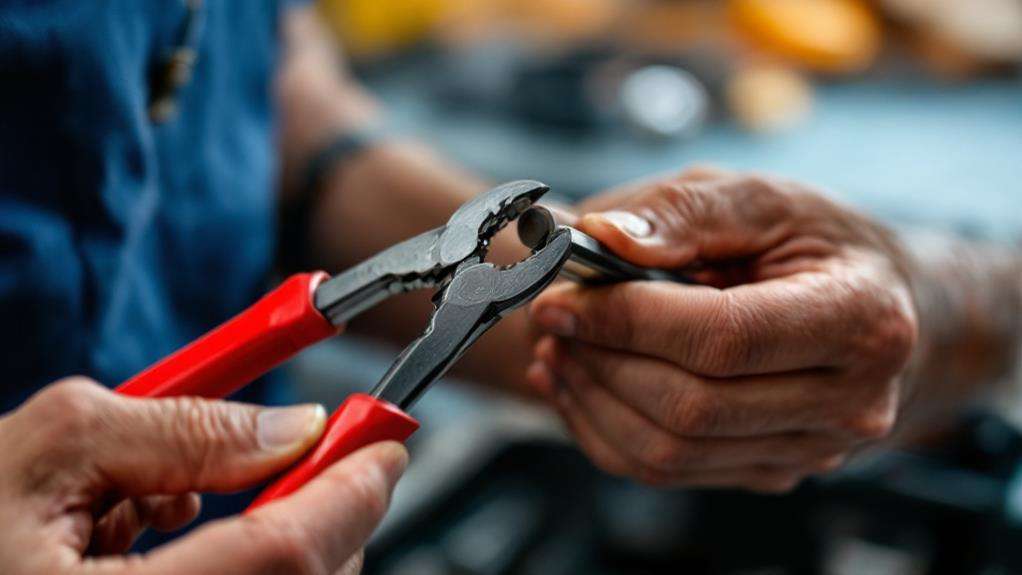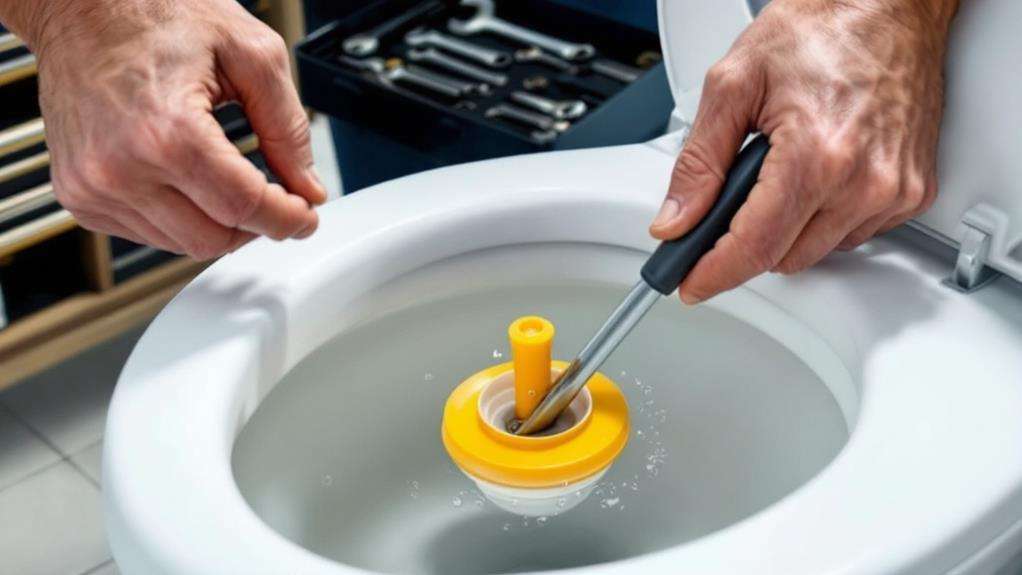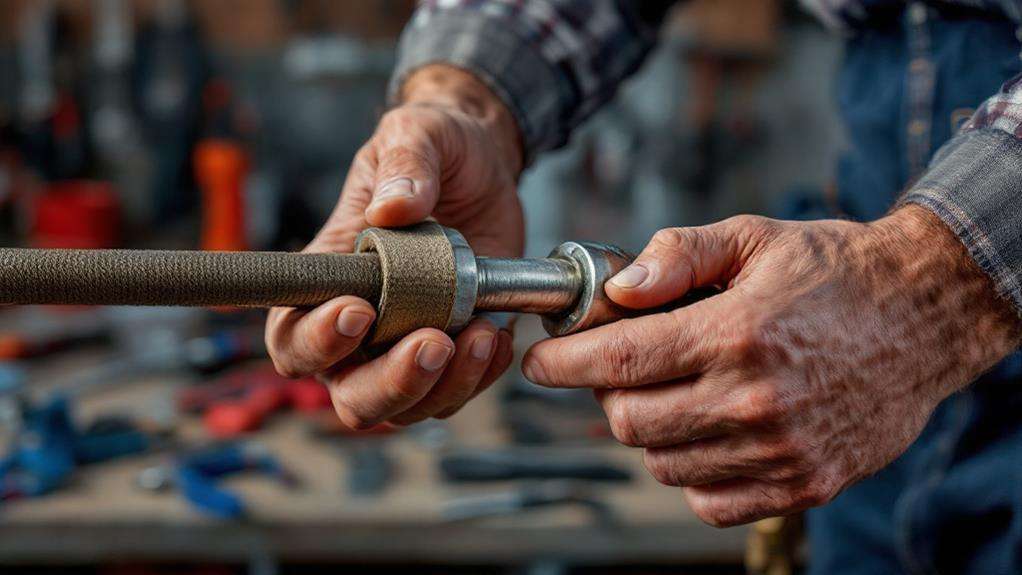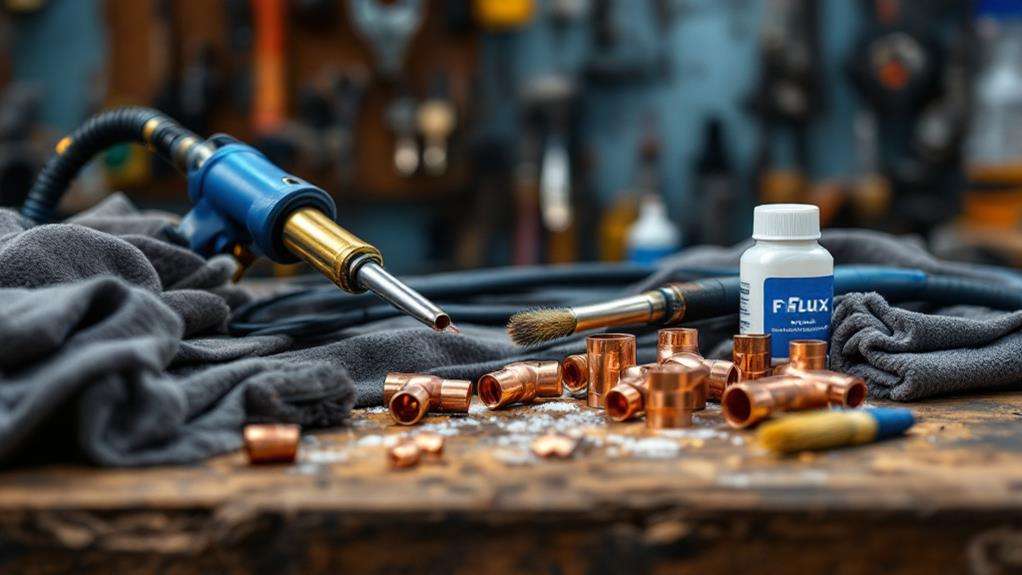How to Avoid Common Plumbing Tool Mistakes
To avoid common plumbing tool mistakes, start by choosing the right wrench for the job and using it correctly. Don't overtighten with pliers, as this can damage fixtures. Apply thread tape clockwise and use the proper type for each application. Grasp the plunger technique for effective clog removal, and handle drain snakes safely. Employ strap wrenches to protect delicate surfaces, and maintain your soldering tools for ideal performance. Always wear appropriate safety gear, including goggles and gloves. By following these tips, you'll prevent costly errors and guarantee successful DIY plumbing repairs. Uncover more ways to enhance your plumbing skills and undertake projects with confidence.
Choosing the Right Wrench
When it comes to plumbing repairs, selecting the appropriate wrench is essential to avoid costly mistakes. Using the wrong tool can lead to further damage and more expensive repairs, so it's critical to choose wisely.
For bathroom fixtures and faucets, opt for a strap wrench instead of standard pliers or wrenches. This will prevent damaging the finish on these delicate surfaces. When working with pipes, a pipe wrench is your go-to tool. However, you must use it correctly to avoid deforming the pipe.
To maintain the pipe's round shape, apply pressure evenly across the wrench jaw rather than relying solely on the teeth. Slide the pipe fully into the wrench jaw to guarantee an even distribution of force. This technique helps prevent pipe distortion and makes your repairs more effective.
Always maintain a three-point contact with the pipe when using a pipe wrench. This approach distributes the force evenly and reduces the risk of damaging the pipe. Remember, proper tool selection and usage are key to successful plumbing repairs. By choosing the right wrench and using it correctly, you'll save time, money, and frustration in the long run.
Proper Use of Pipe Cutters
Proper pipe cutter use is essential for clean, accurate cuts in plumbing projects. When using pipe cutters, you'll want to position them perpendicular to the pipe to guarantee a straight cut. This positioning is indispensable for preserving the pipe's integrity and preventing deformation or cracking.
For more precise results, opt for a tubing cutter instead of a hacksaw. Tubing cutters provide a squarer cut, which is pivotal for proper pipe fitting. As you're cutting, apply even, steady pressure to avoid damaging the pipe. This consistent pressure helps maintain the pipe's shape and prevents potential leaks in the future.
To extend the lifespan of your pipe cutter blade, consider lubricating it with pipe threading oil or cutting fluid. This simple step can greatly improve the tool's performance and longevity. Don't forget to maintain your pipe cutter regularly by keeping the blade sharp and clean. Proper care ensures precise cuts every time you use the tool.
Avoiding Overtightening With Pliers

To avoid overtightening with pliers, it's crucial to understand the delicate balance between securing a connection and causing damage. When working on bathroom fixtures, you might make the mistake of reaching for standard pliers or wrenches. However, these tools can easily scratch and mar the chrome finish, leading to unsightly damage and potential rust formation.
Instead, consider using a strap wrench designed specifically for plumbing applications. These tools provide a gentle yet firm grip on fixtures without risking surface damage. When working with pipes, be cautious not to apply excessive force with just the teeth of a wrench. This can distort the pipe's shape, compromising its integrity and potentially causing leaks.
To maintain the pipe's roundness, slide it fully into the wrench jaw, ensuring contact at three points. This distributes the pressure evenly and reduces the risk of deformation. Remember, improper tool selection can lead to more extensive damage and costly repairs down the line. By choosing the right tools and applying appropriate pressure, you'll protect your plumbing fixtures and pipes while still achieving secure connections. Always prioritize precision over brute force when tightening plumbing components.
Correct Application of Thread Tape
Maneuvering the complexities of thread tape application can make or break your plumbing project. Often called plumbers tape, this essential tool requires careful attention to detail for proper use. When applying thread tape, make sure you're wrapping it clockwise around the threads. This direction is paramount for the tape to function correctly and prevent leaks.
Using the wrong type of tape for your specific application can lead to serious issues. For water-carrying fittings, opt for thin white or thick pink thread tape. If you're working with gas line connections, always use yellow gas-rated tape. It's critical to recognize that thread tape should never be used on compression or flare fittings.
Avoid the common mistake of wrapping the tape backward, as this defeats its purpose and can result in leaks. Remember, improper application of thread tape can cause significant plumbing problems down the line. Take your time to ensure you're using the right type of tape and applying it correctly. By becoming proficient in this simple yet vital skill, you'll greatly improve the quality and longevity of your plumbing work.
Mastering the Plunger Technique

Plunger prowess is vital for tackling common drain clogs effectively. When faced with a stubborn blockage, you'll need to command the proper plunging technique to avoid common DIY plumbing mistakes. Start by creating a tight seal over the drain opening with your plunger. This pivotal step guarantees you're building the necessary pressure to dislodge the clog.
Once you've established a good seal, use short, powerful strokes to thrust the plunger up and down rapidly. This action creates the pressure needed to break up the blockage. Be careful not to apply excessive force, as this can lead to ineffective plunging and potential water splashing. Maintain the seal throughout the process to maximize the pressure buildup.
If you've been plunging for an extended period without success, it's time to ponder alternative methods. A more serious clog may require a drain snake or professional assistance. After successfully clearing the drain, clean your plunger thoroughly and store it in an easily accessible location. This ensures you're prepared for future plumbing emergencies. By commanding the plunger technique, you'll be well-equipped to handle many common drain issues without resorting to costly professional services.
Safe Handling of Drain Snakes
Wielding a drain snake effectively requires caution and skill to prevent damage to your plumbing and yourself. When tackling plumbing tasks with a drain snake, also known as a plumber's snake, it's vital to use the right tools and techniques to avoid common mistakes.
First, always shut off the water before attempting to use a drain snake. As you feed the snake into the drain, be mindful not to extend it too far, as this can cause kinking or lodging, potentially requiring professional extraction. Maintain control of the snake's coils to prevent it from whipping around, which could cause injury or damage to surrounding surfaces.
Don't forget to wear proper protective equipment, such as gloves, to shield your hands from cuts and abrasions. Be careful not to apply excessive force when using the snake, as this could push the clog further into the pipe or even puncture the drain line, leading to costly repairs.
If you're unsure about your ability to safely handle a drain snake or encounter persistent clogs, it's best to call a professional. They have the proficiency and specialized equipment to tackle complex plumbing issues without risking damage to your pipes or personal injury.
Using Strap Wrenches Effectively

Have you ever struggled with removing a stubborn fixture without damaging its finish? That's where strap wrenches come in handy. These versatile tools are designed to securely grip plumbing fixtures while preventing damage to delicate chrome or finished surfaces.
When working with odd-shaped fixtures like tub spouts, you'll find strap wrenches particularly effective. They provide a three-point contact, distributing force evenly and avoiding deformation. This is paramount when dealing with old plumbing, where maintaining the original shape of pipes and fittings is critical.
Using a strap wrench correctly can help you avoid common mistakes that leave telltale signs of improper tool use. Teeth marks on fixtures are a dead giveaway that someone used pliers or other unsuitable tools, which can scratch and damage the finish. By opting for a strap wrench, you'll safeguard the integrity of your plumbing fixtures.
Remember to clean the surface before applying the strap wrench for a better grip. If you're installing new fixtures, don't forget to use Teflon tape on threaded connections to guarantee a proper seal. With these tips in mind, you'll be using strap wrenches like a pro in no time.
Preventing Damage With Basin Wrenches
Many DIY plumbers underestimate the importance of using the right tool for the job, especially when it comes to basin wrenches. These specialized tools are designed to access tight spaces and remove faucet connections without damaging the fixture's finish. To make the most of your basin wrench and prevent damage to plumbing components, it's essential to use it correctly.
When applying force with a basin wrench, ensure you've fully inserted the pipe or fixture into the adjustable jaws. This helps distribute the force evenly and prevents deformation. However, be cautious not to overdo it, as excessive force can still distort the metal. Tighten gradually and carefully to avoid any mishaps.
Choose the right size basin wrench for your specific job. Different sizes accommodate various pipe and fixture dimensions, guaranteeing a proper fit. By using a basin wrench instead of standard pliers or wrenches, you'll avoid unsightly scratches or gouges on delicate bathroom fixtures. Remember, the goal is to complete your plumbing task efficiently while preserving the integrity and appearance of your fixtures. With proper technique and the right tool, you'll make quick work of even challenging plumbing jobs.
Proper Care of Soldering Tools

Proper care of soldering tools is crucial for achieving high-quality plumbing connections and extending the life of your equipment. When using a torch, maintain a clean and controlled flame to prevent overheating and damaging pipes or fittings. This is especially important when working with old piping, which may be more susceptible to heat damage.
Apply flux evenly to joint surfaces with a plumbing-specific flux brush. This guarantees proper heat transfer and adhesion when soldering. Choose lead-free solder formulated for copper plumbing connections to comply with safety regulations and achieve reliable joints.
Store your tubing cutter blades in a dry place to prevent rust and maintain their sharpness. This will help you make clean, precise cuts during your plumbing projects. Regularly clean your emery cloth or sandpaper to remove built-up oxidation, ensuring effective pipe preparation for soldering.
Consider using heat transfer plates when soldering near vulnerable materials to protect them from excessive heat. By properly caring for your soldering tools and following these practices, you'll improve the quality of your work and extend the lifespan of your equipment, saving time and money in the long run.
Essential Safety Gear for Plumbing
Safety should always be your top priority when tackling plumbing projects. To protect yourself from potential hazards, it's essential to wear the right gear. Start by putting on safety goggles to shield your eyes from debris and splashes. These can prevent serious injuries, especially when you're working overhead or dealing with pressurized water.
Don't forget to wear thick rubber gloves to protect your hands from chemicals and hot pipes. They'll also give you a better grip when handling tools. Slip-resistant shoes are indispensable to prevent falls on wet surfaces, which are common in plumbing work and can lead to serious injuries.
Make certain to have proper ventilation when working with solvents or other fumes to avoid inhaling harmful chemicals. This is particularly important in enclosed spaces like bathrooms or basements. Always have a water shut-off tool handy to quickly turn off the water supply in emergencies. This can help prevent extensive water damage if you accidentally hit a pipe or encounter a sudden leak.
While these safety measures are vital, remember that some jobs are best left to a professional plumber. If you're unsure about a task or encounter a complex issue, don't hesitate to call an expert. They can help you check for leaks and confirm your plumbing system is functioning correctly.
